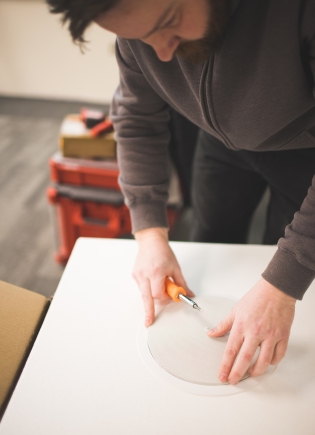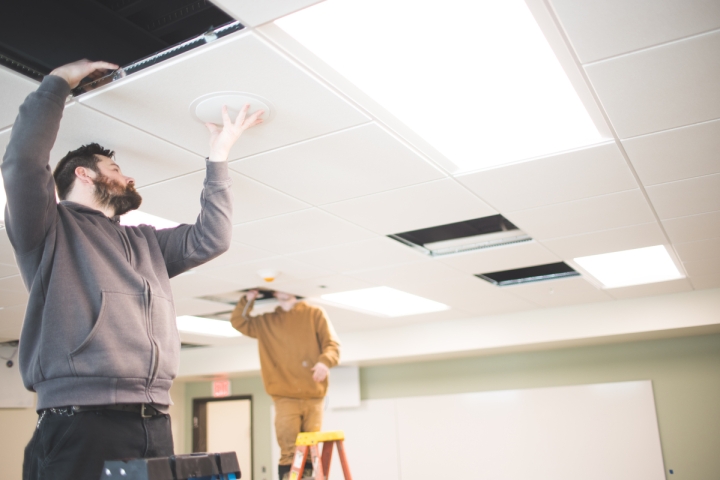Founded more than 250 years ago, Dartmouth has a venerable campus that boasts historic buildings, mature trees—and some aging classrooms that are about to be brought into the 21st century.
“I remember when I first came here five years ago,” says Vice President of Information, Technology, and Consulting and Chief Information Officer Mitchel Davis. “I was going on a tour with one of my staff who graduated about 25 years ago, and he said, ‘I sat in this very room, and those are the chairs I sat in.’”
Davis is part of a campuswide push to modernize the technology, furnishings and adaptability of the 100 or so Arts and Sciences and Guarini School of Graduate and Advanced Studies classrooms. The Provost’s Advisory Committee on Classrooms, which is comprised of representatives from departments across campus, has been tasked with planning an ongoing, five-year renovation cycle for all the classrooms called Dartmouth Classroom Rapid Refresh.
“I don’t think any department said, ‘Oh, we don’t want to build the best classroom,’” Davis says. “We just didn’t know how to get there. So the goal from the provost’s office was to figure this out.”
The idea is to tackle about 20 classrooms per year over five years, and then start back at the beginning to ensure rooms stay up to date.
Renovations begin this summer and fall, with rooms in Wilder and Silsby first on the schedule. Demonstration classrooms will be available in April, where faculty can familiarize themselves with the new designs. The idea is to tackle about 20 classrooms per year over five years, and then start back at the beginning to ensure rooms stay up to date.
“It’s like painting a bridge, like the Golden Gate,” Davis says.
Dartmouth is an older campus, with buildings of various ages that have been renovated at different times. That variability has created a number of challenges. Professors who know how to start a Zoom meeting in one classroom might struggle in a room with a different tech setup. Classes that benefit from working in small groups could have trouble in a room where all the chairs are bolted to the floor. And it takes a lot of time to update AV software when equipment can vary from classroom to classroom.
The goal of the rapid refresh project is to establish five standardized room types across campus—avoiding unusual, one-off designs—that can be adapted for different purposes and share a user-friendly tech platform. There may be new cameras, microphones, projectors, and speakers, but the hope is that a common audio-visual interface will make even a new classroom feel familiar.
“So faculty, students, and staff can walk into rooms, and the systems they interact with and the designs they interact with are the same,” says Dushyandhan Yuvarajan, the program manager for the initiative. “Nothing is going to catch them out.”
Because students coming to Dartmouth have grown up with computers and mobile devices, Yuvarajan says, outdated AV tech and inflexible classroom arrangements don’t always speak to the way they learn. And as technology and teaching methods continue to evolve, the rapid refresh initiative will help classrooms remain current.

“So what this is really doing is helping Dartmouth keep up with the capability of the students we have,” Yuvarajan says. “And the students are fantastic.”
One key to the success of the updated classrooms, according to Davis and Yuvarajan, is a home-grown system called OpenAV developed by the Thayer School of Engineering’s Computing Services and ITC.
Mark Franklin, Thayer’s senior director of computing services, describes the OpenAV approach as “AV done IT style.” OpenAV software controls all AV systems at Thayer and has been adopted for the classroom refresh project.
Franklin remembers feeling frustrated by the time and cost it would take for vendors to install previous AV systems. And if something didn’t work quite right or broke later, the room’s tech system might be down until the vendor could return with a fix.
“We kept thinking there ought to be a way to do this using the IT tools we know,” Franklin says.
So he and his team built OpenAV using standard IT development and deployment tools.
OpenAV also focuses on making systems easy to use by keeping the complex details hidden, centralized, and in-house. Dartmouth can write and deploy updates to all classrooms at once, so the AV systems’ interfaces across campus will always be consistent and up to date. And Dartmouth can maintain and upgrade those systems without having to wait for an outside vendor.
“We take great pride in making straightforward solutions that work in many contexts,” Franklin says. “And because we built it, we can fix it.”
Dartmouth Center for the Advancement of Learning Director Scott Pauls and Michael Goudzwaard, DCAL associate director of learning innovation, are co-chairs of the Provost’s Advisory Committee on Classrooms. They’d both been involved with ‘classroom update’ committees over the years and are happy to see things moving forward.
The closing of the campus a few years ago during the COVID-19 pandemic helped stress-test some rapid refresh project concepts. People came back comfortable using Zoom, which plays a big role in the classroom updates. And the Registrar’s Office learned it could add afternoon time blocks and spread classes across campus so rooms could be taken offline for a term to be refreshed.
“That’s the piece we were missing, because the schedule always seems so tight that you couldn’t take off more than maybe one or two classrooms, which would not enable you to have the pace to touch them,” says Pauls, who is also a professor of mathematics. “That was actually one of the biggest hurdles to overcome.”
The cost estimate for the rapid refresh project is about $4 million for the first year. The initial classrooms to be refreshed will be standard rooms with no “weird shapes,” according to Pauls, so they can “minimize surprises and maximize success.” They’ll take on more complex rooms in future years once they have more experience, at which point costs could change.
But as Goudzwaard points out, with consistent, predictable work being planned years into the future, Dartmouth can attract competitive bids from contractors seeking long-term jobs.
The project is using contractors for the construction and furnishing, but the AV engineering is being done in-house.
Goudzwaard says that other Ivy League schools are following Dartmouth’s progress. “There’s certainly interest in other places with old campuses like Harvard and Penn, and they’re watching us closely this fall as the first rapid refresh classrooms roll out,” he adds.
Pauls sums up the reason why the project is so important to Dartmouth’s future. “The classrooms are, in some sense, the part of campus which is most critical to the work that we do,” he says. “In that, if we don’t have classes, then we don’t have students, and then we won’t have a college.”
